|
Report from
North America
Sawn tropical hardwood imports continued to rebound
in July
US imports of sawn tropical hardwood improved for the
second straight month in July, rising 12% over June’s
figures. The 17,555 cubic metres of hardwood imported
for the month was 6% less than that imported in July 2023.
Imports from Cameroon and Indonesia both rose more
than 40% in July while imports from Congo (Brazzaville)
were up 36%. Imports from Brazil lagged, falling 23% in
July.
Imports of Sapelli, Mahogany, and Ipe all rose in July to
their highest levels of the year. Total US imports of sawn
tropical hardwood lumber remain down 4% versus 2023
through July.
Canada’s imports of sawn tropical hardwood also rallied
in July, gaining 11% over the previous month to a level
80% higher than a year ago. Imports from Brazil, Ghana,
the US, and Congo (Brazzaville) all rose sharply. Total
Canadian imports are up 44% over last year for the first
seven months of the year.
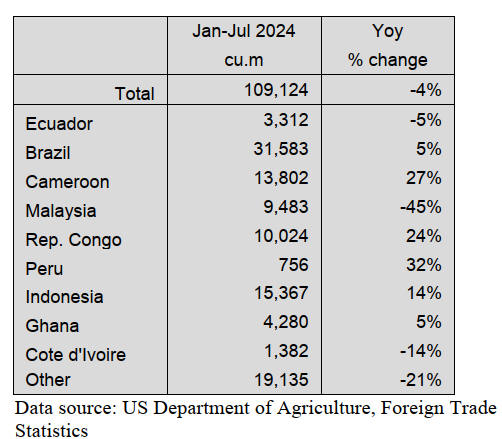
Hardwood plywood imports down from a year earlier
US imports of hardwood plywood rose 9% in July as
imports from its top trading partner surged. Imports from
Vietnam rose by 25% in July and are 95% ahead of last
year for the year so far. Imports from Cambodia and
Russia also gained while imports from Malaysia and
Indonesia saw declines.
While the import volume of 218,817 cubic metres for July
was an improvement over June, it came in 38% below the
volume seen in the previous July. As a result, total US
imports of hardwood plywood, which were outpacing
2023 totals by 32% just a month ago, are now ahead just
14% over last year through July.
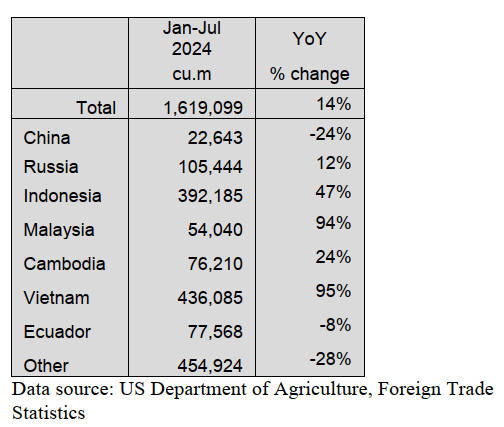
Veneer imports from India and China gained more than
60%
US imports of tropical hardwood veneer rebounded in
July, rising 27% over a disappointing June figure. Imports
from India and China both gained more than 60% for the
month while imports from Italy returned to a more
customary level after two months of poor numbers.
Despite the bounce back, imports from Italy are down
76% so far this year versus last year. Imports from
Cameroon fell 15% from the previous month and were
27% lower than that of last July. Year to date, total
imports of tropical hardwood veneer trail 2023 figures by
4% through the end of July.
Fourth straight month rise for assembled flooring
imports
US imports of assembled flooring panels rose for a fourth
consecutive month in July, rising 10% over the previous
month to a level 31% better than last July. Imports from
Thailand rose 61% to climb to their highest level of the
year. That gain was enough to more than offset declines in
imports from China, Indonesia, Vietnam, and Brazil.
Through July, total imports continue to outpace those of
2023 by 32%.
Imports of hardwood flooring dropped for the second
straight month, falling 11% in July. While imports from
Malaysia and China both more than doubled their June
totals, imports from Vietnam fell to zero for the month
while imports from Brazil fell by 20%. Imports from
Indonesia, the leading US trade partner for flooring panels,
held even with the month before. Total imports of
hardwood flooring are behind last year’s pace by 12%
through July.
Moulding imports cool
Imports of hardwood moulding dipped in July after
reaching their highest level in nearly two years in June. At
over US$14.1 million, July imports were down 10% from
the June high but still 22% higher than a year ago.
A 44% decline in imports from Malaysia triggered the
loss, despite healthy gains in imports from Brazil and
China. Total imports for the year remain up 25% over last
year through the end of July.
US wooden furniture imports rise to highest level in
nearly two years
Imports of wooden furniture saw a 7% boost in July, rising
to their highest level in nearly two years. The US$1.84
billion imported in July was the most since October 2022
and was 10% higher than that of July 2023.
Imports from Indonesia rebounded with a 41% increase in
July after falling about the same amount in June, while
imports from Vietnam and China both saw gains of about
10%. Imports from Canada fell by 7%. For the year so far,
total imports of wooden furniture are ahead of last year by
6%.
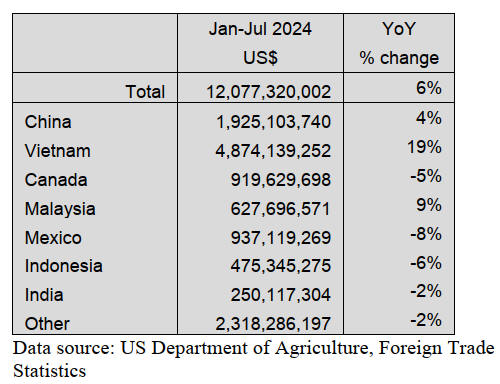
Residential furniture orders shrank for second
consecutive month in June
New orders for residential furniture in the US were down
6% in June 2024 compared to June 2023, which follows
the 3% year-over-year decline last month, according to the
latest issue of Furniture Insights.
New orders were also down 8% compared to the prior
month of May 2024. However, year to date through June
2024, new orders are still up 3% compared to 2023,
though that spread has narrowed significantly with the last
two months’ declines.
June 2024 shipments were down 8% from June 2023, but
relatively flat with May 2024. Year to date through June
2024, shipments are down 9% compared to 2023.
Inventories and employee levels are again materially in
line with recent months, but down from 2023, indicating
that companies have aligned levels to match current
operations.
According to said Mark Laferriere, assurance partner at
Smith Leonard, which produces the monthly report, June
2024 marked the second straight month in which both new
orders and shipments declined over the comparable prior
year month for the companies in our survey.
See:
https://www.woodworkingnetwork.com/furniture/residential-
furniture-orders-down-june
Nonresidential construction employment rises in
August
The construction industry added 34,000 jobs on net in
August, according to an Associated Builders and
Contractors analysis of data released by the US Bureau of
Labour Statistics. On a year-over-year basis, industry
employment grew by 228,000 jobs, an increase of 2.8%.
Nonresidential construction employment increased by
28,300 positions on net, with growth in all three
subcategories. Nonresidential specialty trade added the
most jobs on net, increasing by 14,000 positions. Heavy
and civil engineering and nonresidential building added
13,500 and 800 jobs, respectively.
The construction unemployment rate fell to 3.2% in
August. Unemployment across all industries declined from
4.3% in July to 4.2% last month.
“August’s employment report is perfectly consistent with
the notion of a soft landing,” said ABC Chief Economist
Anirban Basu. “Unemployment fell both economywide
and in the nation’s construction sector. Job growth in
nonresidential construction was both brisk and broad-
based. Moreover, Federal Reserve officials continue to
indicate that they are ready to reduce interest rates, which
is expected within the next two weeks.
“And yet, the level of concern has been rising among
contractors,” said Basu. “According to both ABC’s
Construction Confidence Index and Construction Backlog
Indicator, the outlook among contractors is dimming
gradually. Many projects have been postponed recently in
the context of still-elevated borrowing costs and tighter
lending conditions.”
See: https://www.bls.gov/news.release/empsit.nr0.htm
and
https://www.woodworkingnetwork.com/news/woodworking-
industry-news/nonresidential-construction-employment-rises-
august
Union disputes threaten disruption of US ports and
Canadian railways
Labour disputes this summer led to halted traffic on two
critical Canada railroads and are threatening a possible
strike by workers at US East Coast and Gulf Coast ports in
October.Lockouts of workers briefly stopped traffic in
Canada on the railroads in August and halted shipments to
and from the United States, cutting off delivery of raw
materials, along with shipping of finished products from
factories and to retail shelves.
They lasted a little over a day at CN and four days at
CPKC. Canada’s Labour Minister Steven MacKinnon
ordered CN and CPKC into arbitration with the Teamsters
Canada Rail Conference to end the lockout.
In the US, critical talks between the labour union
representing workers, the International Longshoremen’s
Association (ILA), and ports management broke down
over the summer with automation being a key sticking
point.
Although talks have not resumed and will not until the
union concludes its internal meeting at least one positive
development has risen in recent weeks. Both the ILA and
the US Maritime Alliance (which represents the
employers) contacted the Federal Mediation &
Conciliation Service (FMCS) in late August with the
intention of getting a mediator involved in the talks.
US East Coast and Gulf Coast ports handle 43% of all US
imports and billions of dollars in trade monthly but
companies have been moving shipping containers to the
West Coast over strike fears.
See: https://www.yahoo.com/news/east-coast-port-workers-
reportedly-160943478.html
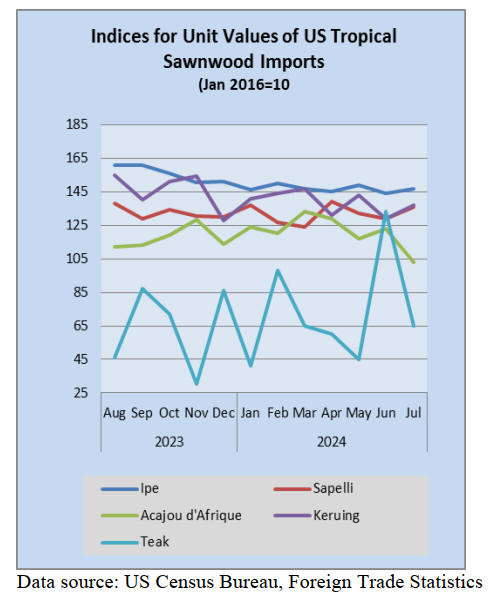
Note: the doubling of the unit value for teak may be a statistical
error. Use with caution.
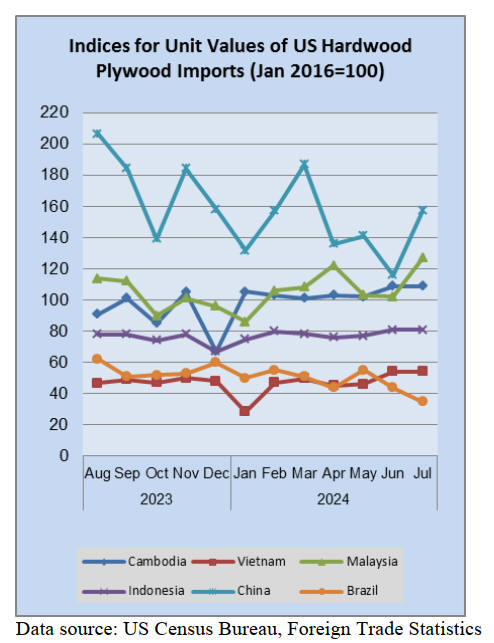
|